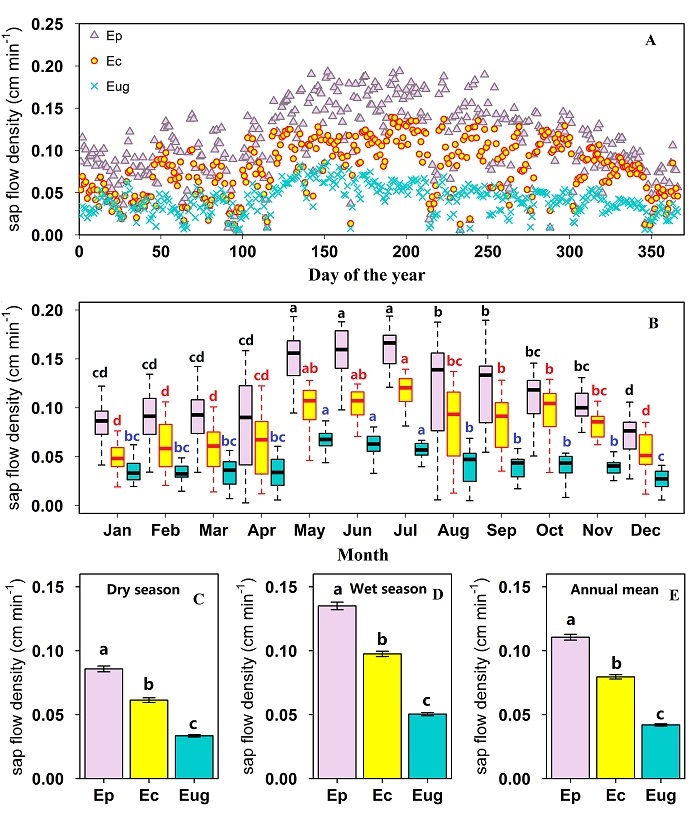
湿地蓄水主要监测方法研究进展
编号
lyqk007721


中文标题
湿地蓄水主要监测方法研究进展


作者单位
中国林业科学研究院林业科技信息研究所, 北京 100091


期刊名称
世界林业研究


年份
2019


卷号
32


期号
4


栏目编号
1


栏目名称
专题论述


中文摘要
在湿地生态系统功能研究中,湿地蓄水功能研究越来越多受到自然科学领域和社会经济领域的关注。文中分析了国内外湿地蓄水功能相关重大研究成果,从数据处理、监测方法及应用研究的角度凝练出具有代表性的3类研究方法及其应用模型,总结了不同研究方法及其模型的适用范围、优势和劣势,从多源数据融合、地表高程监测和应用领域拓展3个方面提出进一步研究湿地蓄水功能的主要趋势,以期为保护、恢复和提高湿地蓄水能力提供理论参考。


基金项目
中央级公益性科研院所基本科研业务费专项资金:青年人才项目——中国林科院杰出青年基金(CAFYBB2017QC006);国家林业局林业重大问题研究“湿地生态效益补偿及还湿政策研究”(500102-5072)。


英文标题
Research Progress in Monitoring Methods of Wetland Water Retention


作者英文名
Song Zheng, He Youjun


单位英文名
Research Institute of Forestry Policy and Information, Chinese Academy of Forestry, Beijing 100091, China


英文摘要
In the study of wetland ecosystem function, more and more attention has been paid to the research of wetland water retention function in the field of natural science and social economy.This paper analyzes the results of major research related to wetland water retention function at home and abroad, summarizes three representative research methods and their application models from the perspective of data processing, monitoring methods and application research, and systematically summarizes the application scope, advantages and disadvantages of the research methods and models. The main trends of further study on wetland water retention function are proposed in terms of multi-source data fusion, surface elevation monitoring and application field expansion, so as to provide theoretical basis for protection, restoration and improvement of wetland water storage capacity.


英文关键词
wetland water retention function;research methods;prediction model


起始页码
12


截止页码
17


投稿时间
2019/1/6


最后修改时间
2019/6/10


作者简介
宋争,博士,助理研究员,主要研究方向为退化湿地生态修复研究,E-mai:songzheng556@163.com。


通讯作者介绍
何友均,博士,研究员,主要研究方向为森林多目标管理与评价、林业战略与规划,E-mail:hyjun163@163.com。


E-mail
何友均,博士,研究员,主要研究方向为森林多目标管理与评价、林业战略与规划,E-mail:hyjun163@163.com。


分类号
P941.78


DOI
10.13348/j.cnki.sjlyyj.2019.0054.y


参考文献
[1] ROY S K, SARKER S C. Aerial extent analysis and environmental problems identification of Matasagar and Sukhsagar Wetlands in Bangladesh using GIS and remote sensing tools[J]. Journal of Geographic Information System,2016,8(6):683-691.
[2] 肖飞,蔡述明,杜耘.洪湖湿地抗渍蓄洪能力分析[J].湖泊科学,2003(12):243-248.
[3] 樊勇,喻光明,王正.洪湖湿地需水量分析系统的构建与应用[J].华中师范大学学报(自然科学版), 2013,47(1):136-140.
[4] 冯夏清,章光新.基于水循环模拟的流域湿地水资源合理配置初探[J].湿地科学,2012,10(4):459-466.
[5] GIBBS J P.Wetland loss and biodiversity conservation[J].Conserva-tion Biology,2000,14(1):314-317.
[6] 穆宏强.SCS模型在石桥铺流域的应用研究[J].水利学报,1992(10):79-83.
[7] NASH J E,SUTCLIFFE J V.River flow forecasting through conceptual models:part I:a discussion of principles[J].Journal of Hydrology,1970,10(3):282-290.
[8] OGAWA H,MALE J W.Simulating the flood mitigation role of wetlands[J].Journal of Water Resources Planning and Management,1986,112(1):114-128.
[9] BEVEN K,GERMANN P F.Macropores and water flow in soils[J].Water Resources Research,1982,18(5):1311-1325.
[10] 孔凡哲,李莉莉.数字高程模型在新安江模型中的应用研究[J].中国矿业大学学报,2006,35(3):393-396,402.
[11] HESS L L,MELACK J M,FILOSO S,et al.Delineation of inundated area and vegetation along the Amazon Floodplain with the SIR-C synthetic aperture radar[J].Transactions on Geoscience and Remote Sensing,1995,33(4):896-904.
[12] POPE K O,REJMANKOVA E,PARIS J F,et al. Detecting seasonal flooding cycles in Marshes of the Yucatan Peninsula with SIR-C polarimetric radar imagery[J]. Remote Sensing of Environment,1997,59(2):157-166.
[13] 宗净.城市的蓄水囊——滞留池和储水池在美国园林设计中的应用[J].中国园林,2005,21(3):51-55.
[14] 刘锦.淮河中游地区建立蓄水湿地的可行性研究[J].淮南职业技术学院学报,2009,9(2):38-40.
[15] 肖笃宁.三角洲湿地景观的水文调节与防洪功能[J].湿地科学,2003,1(1):21-25.
[16] 刘兴土.三江平原沼泽湿地的蓄水与调洪功能[J].湿地科学,2007,5(1):64-68.
[17] 吴江琪,马维伟,李广.尕海沼泽化草甸湿地不同地下水位土壤理化特征的比较分析[J].草地学报,2018,26(2):341-347.
[18] 康文星,何介南,席宏正.洞庭湖滩涂和草甸沼泽湿地调蓄水量的功能研究[J].水土保持学报,2008,22(5):209-212.
[19] KIM S W,WDOWINSKI S,AMELUNG F,et al.C-band interferom-etric SAR measurements of water level change in the wetlands:examples from florida and louisiana[C]. International Geoscience & Remote Sensing Symposium,Seoul,2005.
[20] ALSDORF D E. Interferometric SAR observations of water level changes:potential targets for future repeat-pass AIRSAR missions[C].AIRSAR Earth Science and Application Workshop Pasadena,2002.
[21] GRINGS F M,FERRAZZOLI P,KARSZENBAUM H,et al.Model investigation about the potential of C band SAR in herbaceous wetlands flood monitoring[J]. International Journal of Remote Sensing, 2008,29(17/18):5361-5372.
[22] GAMBLE D,GRODY E,UNDERCOFFER J,et al. An ecological and functional assessment of urban wetlands in Central Ohio volume 2:morphometric surveys, depth-area-volume relationships and flood storage function of urban wetlands in central Ohio:EPA technical report WET/2007-3B[R]. Columbus:Ohio Environmental Protection Agency, 2007.
[23] GRINGS F,SALVIA M,KARSZENBAUM H,et al. Exploring the capacity of radar remote sensing to estimate wetland marshes water storage[J]. Journal of Environmental Management, 2009, 90(7):2189-2198.
[24] MAXA M,BOLSTAD P.Mapping northern wetlands with high resolution satellite images and LiDAR[J].Wetlands,2009,29(1):248-260.
[25] 熊立华,郭生练.利用DEM提取地貌指数的方法述评[J].水科学进展,2002,13(6):775-780.
[26] 樊勇,喻光明,王正.洪湖湿地需水量分析系统的构建与应用[J].华中师范大学学报(自然科学版), 2013,23(1):136-140.
[27] 徐伟平,康文星,何介南.洞庭湖蓄水能力的时空变化特征[J].水土保持学报,2015,29(3):62-67.
[28] 肖飞,蔡述明,杜耘.洪湖湿地抗渍蓄洪能力分析[J].湖泊科学,2003,15(增刊1):243-246.
[29] 王学雷,吴宜进.江汉平原典型区域洪涝调蓄能力估算研究[J].武汉大学学报(理学版),2002,48(4):461-465.
[30] 蔡青,黄璐,梁婕.基于MODIS遥感影像数据的洞庭湖蓄水量估算[J].湖南大学学报(自然科学版),2012,39(4):64-69.
[31] NATHAN J C,EVENSON G R,MCLAUGHLIN D L,et al.Estimating restorable wetland water storage at landscape scales[J].Hydrological Processes,2017,32(2):305-313.
[32] 熊立华,郭生练.分布式流域水文模型[M].北京:中国水利水电出版社,2004.
[33] 赵人俊.流域水文模拟:新安江模型与陕北模型[M].北京:水利电力出版社,1984.
[34] 石朋,芮孝芳,瞿思敏.一种通过地形指数计算流域蓄水容量的方法[J].水科学进展,2008,19(2):264-267.
[35] 张莹,李致家,缪成晨,等.一种基于TOPMODEL模型求解流域蓄水容量分布的方法[J].水力发电,2017,43(12):17-19,44.
[36] LIANG X,LETTENMAIER D P,WOOD E F,et al.A simple hydrologically based model of land surface water and energy fluxes for general circulation models[J].Journal of Geophysical Research:Atmospheres,1994,99(D7):14415-14428.
[37] BOWLING L C,LETTENMAIER D P.Modeling the effects of lakes and wetlands on the water balance of arctic environments[J].Journal of Hydrometeorology,2010,11(11):276-295.
[38] BOHN T J,VIVONI E R.Process-based characterization of evapotranspiration sources over the North American monsoon region[J].Water Resources Research,2016,52(1):358-384.
[39] WONG C P,JIANG B,BOHN T J,et al.Lake and wetland ecosystem services measuring water storage and local climate regulation[J]. Water Resources Research,2017,53(4):3197-3223.
[40] DÖLL P,KASPAR F,LEHNER B.A global hydrological model for deriving water availability indicators:model tuning and validation[J]. Journal of Hydrology,2003,270(1):105-134.
[41] DÖLL P, FIEDLER K. Global-scale modeling of groundwater recharge[J]. Hydrology and Earth System Sciences,2008,12(3):863-885.
[42] HUNGER M, DÖLL P. Value of river discharge data for global-scale hydrological modeling[J].Hydrology and Earth System Sciences,2007,12(3):841-861.
[43] WOUTERS B,CHAMBERS D,SCHRAMA E J O.Grace observes small-scale mass loss in greenland[J].Geophysical Research Letters,2008,35(20):295-296.
[44] NIU G Y,YANG Z L,DICKINSON R E,et al.Development of a simple groundwater model for use in climate models and evaluation with Gravity Recovery and Climate Experiment data[J]. Journal of Geophysical Research Atmospheres, 2007, 112(D7):D07103.DOI:10.1029/2006JD007522.
[45] PAPA F, GÜNTNER A, FRAPPART F,et al. Variations of surface water extent and water storage in large river basins:a comparison of different global data sources[J].Geophysical Research Letters,2009,35(11):253-267.
[46] HORWATH M,DIETRICH R.Errors of regional mass variations inf-erred from GRACE monthly solutions[J].Geophysical Research Letters,2006,33(7):L07502.DOI:10.1029/2005GL025550.
[47] KUSCHE J.Approximate decorrelation and non-isotropic smoothing of time-variable GRACE-type gravity field models[J]. Journal of Geodesy, 2007,81(11):733-749.
[48] WERTH S,GÜNTNER A,SCHMIDT R,et al.Evaluation of GRACE filter tools from a hydrological perspective[J].Geophysical Journal International,2009,179(3):1499-1515.
[49] SYED T H,FAMIGLIETTI J S,RODELL M,et al.Analysis of terr-estrial water storage changes from GRACE and GLDAS[J].Water Resources Research,2008,44(2):339-356.
[50] ANDREAS G.Improvement of Global hydrological models using GR-ACE data[J].Surveys in Geophysics,2008,29(4/5):375-397.
[51] ZAITCHIK B F,RODELL M,REICHLE R H.Assimilation of GRACE terrestrial water storage data into a land surface model:results for the mississippi river basin[J].Journal of Hydrometeorology,2008,9(3):535-548.
[52] WERTH S,GÜNTNER A,PETROVIC S,et al.Integration of GRACE mass variations into a global hydrological model[J].Earth and Planetary Science Letters,2009,277(1/2):166-173.
[53] LO M H,FAMIGLIETTI J S, YEH P J F,et al.Improving parameter estimation and water table depth simulation in a land surface model using GRACE water storage and estimated base flow data[J].Water Resources Research,2010,46(5):1-15.
[54] WERTH S, GÜNTNER A.Calibration analysis for water storage var-iability of the global hydrological model WGHM[J]. Hydrology and Earth System Sciences,2010,14(1):59-78.


PDF全文
浏览全文


-
相关记录
更多
- 新西兰森林火险等级系统及预测应用 2022
- 世界森林雷击火研究现状和展望 2022
- 林木全基因组选择研究现状和应用 2021
- 城市森林结构多样性预测冠下地面温度的潜力研究 2024
- 近10年城市绿色空间与心理健康国际研究进展——理论框架、对象、测量工具与指标 2022
- 基于叶形分类的淡竹叶面积预测模型研究 2020
 打印
打印


